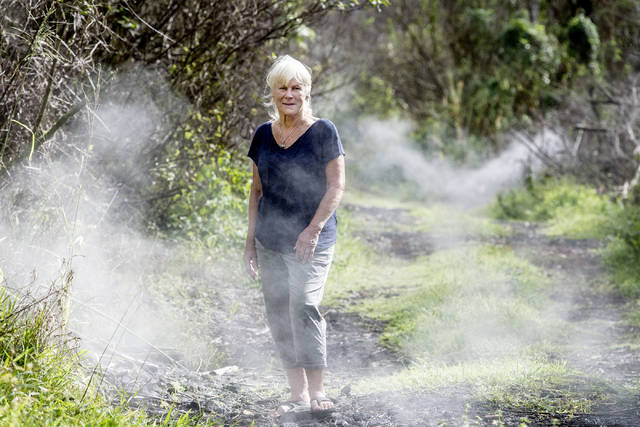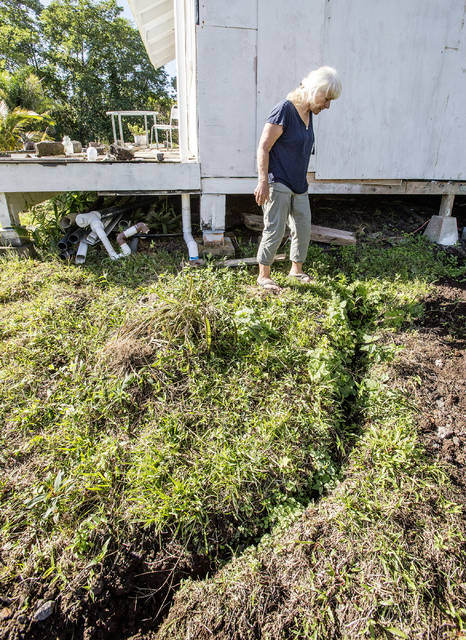Heide Austin once wished to have steam vents on her 6-acre property, where she could relax in the breath of Pele like she sometimes did at the Steam Vent Inn on the other side of Highway 130.
“You could go inside and get steamed and meditate in the earth,” she said, regarding the vents that have been present since the 1955 eruption.
Now, Austin sees them in a much different light.
When the recent Kilauea eruption started in May, steaming cracks opened across her long, unpaved driveway, which crosses her neighbor’s land as well as the volcano’s East Rift Zone. They don’t show any signs of abating.
While lava from the eruption retreated back into the earth in early September from fissures downrift, and hasn’t been seen since, the ground fractures and hot earth are a constant reminder for her that magma may continue to lurk not far below her feet.
“This is what I would have to run across if I had to leave,” Austin said, as she walks through ever-present clouds of steam that rise from the ground.
On rainy days, it’s worse, she comments. On this day, the sky was clear and sunny.
More light shines through the forest canopy these days as much of the vegetation was killed off by volcanic gases that are now absent.
“You couldn’t see this much into the forest before,” Austin remarks, while pointing out the bare trees.
The ground, which remains hot to the touch in places, also makes it hard for vegetation to return, aside from some grass or vines that climb dead trees in search of light.
“The ground is too hot to support life,” she explained. “The ground, when it rains, it doesn’t get wet.”
Needless to say, the driveway has been a point of interest for Hawaiian Volcano Observatory scientists.
Carolyn Parcheta, HVO geologist, said 17 cracks have been documented, some a few inches across, others more like a hairline.
While some cracks remain near the boiling point, there are no signs that the eruption could resume there, or anywhere else for that matter.
“The trends we’ve been seeing, the cracks are pretty stable,” Parcheta said.
One or two have widened a bit, but that may be to the ground settling, she said.
Austin remains concerned.
She said the steam cracks appear to be migrating closer to her house, which itself is damaged by ground cracks that so far have not produced any steam. Austin said the cracks under her home are from the 6.9-magnitude quake that struck shortly after the eruption began.
“It’s going to happen here,” she said, as she points to blackened soil next to the driveway. She said that’s a sign that the ground is about to open there.
The air above it was hot, even if no steam was visible.
Asked about new cracks forming, Parcheta said the appearance of them may be because some small ones get covered by soil, which is later washed away. She said geologists check the cracks about every week and see no reason for alarm.
For the time being, Austin, 77, is moving into one of the micro unit shelters at Pahoa Sacred Heart Catholic Church after renting a place near the town.
She said she may need more than $20,000 to repair her home.
Austin said she has received $2,000 from the Federal Emergency Management Agency, as well as rental assistance, but is seeking more to cover the costs.
Even then, she may still have to contend with the steam cracks for a long time.
Parcheta said they could last for years, much like those across the highway that opened during ‘55 eruption.
It also could be several years before Kilauea sees another substantial eruption.
Parcheta said the major earthquake created more cavities in the volcano that make it harder for it to build pressure for the time being.
“There’s more volume to fill before it can get back to where it was,” she said.
A recent scientific paper penned by HVO geologists and other researchers noted the quake on Kilauea’s south flank was likely located on a fault between the “volcanic pile and pre-existing seafloor,” and that models indicate up to 5 meters of seaward fault slip.
The paper says eruptions may become smaller and less frequent in the following years, as was seen after the 7.7-magnitude Kalapana earthquake in 1975.
That quieter period, which included three small eruptive events, ended in 1983 when the Pu‘u ‘O‘o eruption began. That lasted until magma moved down rift and started the latest eruption in May.
“The (May 4 earthquake) marked an important event in the magmatic cycle of Kilauea volcano,” the paper published in Science Magazine says.
“… A suggested cycle, in which the flank progressively stiffens as it nears the next flank earthquake, results in gradually increasing magmatic head and more frequent eruptive activity. Once the flank slips, the magmatic head drops, and eruptions become smaller and less frequent.”
The paper also notes evacuation of magma from the summit, coupled with the loss of the magmatic head, “suggests it may take several years before enough magma can accumulate beneath the summit to erupt.” It adds that a pressure imbalance may cause renewed activity sooner than expected.
The cracks on Austin’s driveway follow the riftzone, which goes across Highway 130 through Leilani Estates, where the recent eruption started.
Parcheta said the magma dike is estimated to have been a mere 100 yards beneath the surface where it crosses under the highway.
That, by itself, may be unsettling enough for those who live nearby.
“If something happens down here, I can’t run,” Austin said.
“I’m just really hoping Pele will find another way.”
Email Tom Callis at tcallis@hawaiitribune-herald.com.









